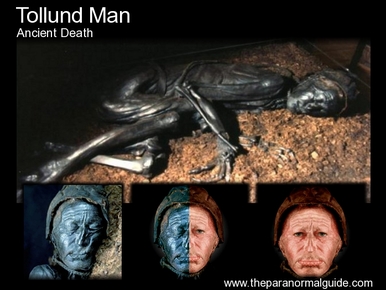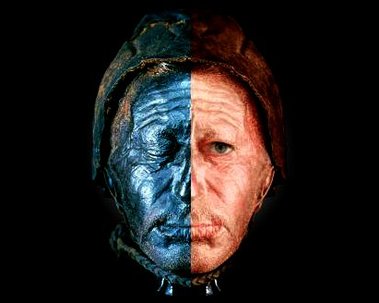
Discovered in a peat bog in Denmark, this man, who they believe was sacrificed to the gods, has given modern day historians a rare glimpse into life in the early Iron Age.
Iron Age Life and Death
 Tollund Man on display in the Silkeborg Museum.
Tollund Man on display in the Silkeborg Museum. When the police arrived, they were quite surprised by the condition of the body. They attempted to identify a time of death, and were having trouble, so called in an archaeologist named Professor Glob. The Professor surprised everyone by proclaiming that the corpse was at least 2,000 years old, and appeared to be a victim of ritual sacrifice.
And so he was named the Tollund Man. His name was an obvious choice, as the family who found him came from the small village of Tollund, which was not far from the peat bog.
The side of his body which was turned downwards in the grave was incredibly well preserved. Only the side facing upwards showed signs of decomposition. It is believed that the body had shrunk throughout the decomposing stages, and as it was found, measured at 161 centimetres.
The only parts of his body which were pretty much ruined were his arms and his hands. They were skeletonized due to peat-digging. His feet were in perfect condition, as was one figure.
 The face of Tollund Man.
The face of Tollund Man. He had no clothing on his body, but a belt made out of thin pieces of leather was tied around his hips. The most telling sign of all though was the leather rope, tightened into a noose, which was secured around his neck.
This noose has intrigued the historians and archaeologists who have been studying the Tollund Man… the rope had left a furrow in the skin under his neck and chin, but not at the back of the neck. His tongue, inside his mouth, was also distended. It was decided that the Tollund had been hanged – although there were some inconsistencies with that as well, such as the fact that there was no vertebrae breakage as is common among hanging victims.
When the scientists removed his body, they found a very thin layer of moss underneath him which they recognised as being present in peat bogs in the early Iron Age… Tollund Man therefore was estimated to have died in 375 – 210 BC. What a remarkable discovery, and one which is believed to be the best preserved corpse from the Iron Age – especially considering the dead in that time were mostly cremated on funeral pyres. His age at the time of death was between 30 and 40 years – an old man by the standards of the time.
During an autopsy, scientist removed the alimentary canal, which consists of the stomach and intestines. They wanted to see if they could find out what the Iron Age people ate. The majority of the meal had passed into the intestines, which showed that he had eaten somewhere between 12 and 24 hours before he died. They found 40 different types of grains and seeds, and no traces of meat, fish or fruit/vegetable matter.
 Reconstruction of the face.
Reconstruction of the face. Tacitus wrote: "They hang traitors and renegades in trees, cowards (yellow), combat evaders (afraid to go to war) and unnaturally immoral people they lower into filthy swamps and cover them with branches".
He also noted that in some tribes, human sacrifices were made to the gods.
Both of these are possibilities, but scientists tend to think that the second option is more likely, due to the care taken with placing him in the bog, in a sleeping position. Such care shows affection, not anger. It is also believed that his eyes were closed after death, another small gesture of affection. It is these small things which make it possible that Tollund Man was sacrificed to some forgotten god or gods.
If you’re ever in Denmark, head to the Silkeborg Museum, where you can find the Tollund Man’s remains.





 RSS Feed
RSS Feed
